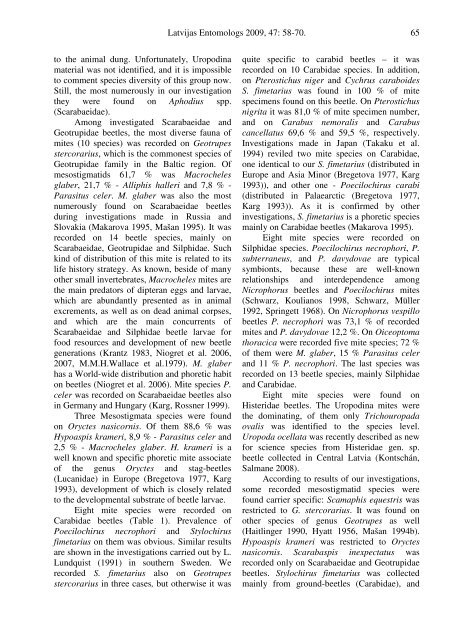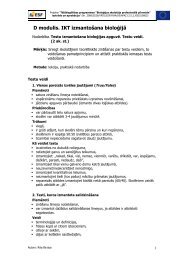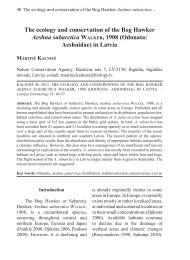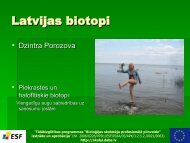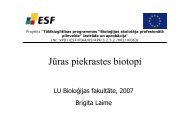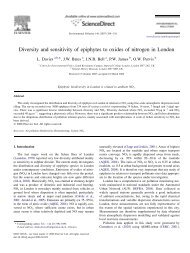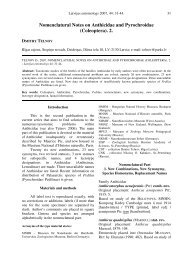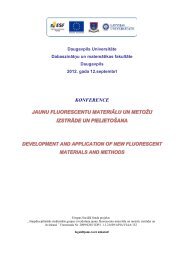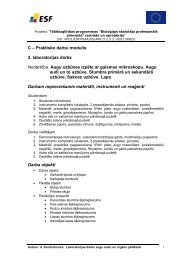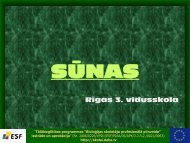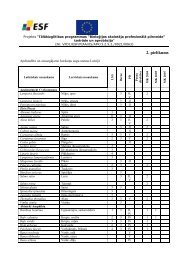Mesostigmata Mites (Acari: Parasitiformes) - Entomological Society ...
Mesostigmata Mites (Acari: Parasitiformes) - Entomological Society ...
Mesostigmata Mites (Acari: Parasitiformes) - Entomological Society ...
- No tags were found...
You also want an ePaper? Increase the reach of your titles
YUMPU automatically turns print PDFs into web optimized ePapers that Google loves.
Latvijas Entomologs 2009, 47: 58-70. 65to the animal dung. Unfortunately, Uropodinamaterial was not identified, and it is impossibleto comment species diversity of this group now.Still, the most numerously in our investigationthey were found on Aphodius spp.(Scarabaeidae).Among investigated Scarabaeidae andGeotrupidae beetles, the most diverse fauna ofmites (10 species) was recorded on Geotrupesstercorarius, which is the commonest species ofGeotrupidae family in the Baltic region. Ofmesostigmatids 61,7 % was Macrochelesglaber, 21,7 % - Alliphis halleri and 7,8 % -Parasitus celer. M. glaber was also the mostnumerously found on Scarabaeidae beetlesduring investigations made in Russia andSlovakia (Makarova 1995, Mašan 1995). It wasrecorded on 14 beetle species, mainly onScarabaeidae, Geotrupidae and Silphidae. Suchkind of distribution of this mite is related to itslife history strategy. As known, beside of manyother small invertebrates, Macrocheles mites arethe main predators of dipteran eggs and larvae,which are abundantly presented as in animalexcrements, as well as on dead animal corpses,and which are the main concurrents ofScarabaeidae and Silphidae beetle larvae forfood resources and development of new beetlegenerations (Krantz 1983, Niogret et al. 2006,2007, M.M.H.Wallace et al.1979). M. glaberhas a World-wide distribution and phoretic habiton beetles (Niogret et al. 2006). Mite species P.celer was recorded on Scarabaeidae beetles alsoin Germany and Hungary (Karg, Rossner 1999).Three <strong>Mesostigmata</strong> species were foundon Oryctes nasicornis. Of them 88,6 % wasHypoaspis krameri, 8,9 % - Parasitus celer and2,5 % - Macrocheles glaber. H. krameri is awell known and specific phoretic mite associateof the genus Oryctes and stag-beetles(Lucanidae) in Europe (Bregetova 1977, Karg1993), development of which is closely relatedto the developmental substrate of beetle larvae.Eight mite species were recorded onCarabidae beetles (Table 1). Prevalence ofPoecilochirus necrophori and Stylochirusfimetarius on them was obvious. Similar resultsare shown in the investigations carried out by L.Lundquist (1991) in southern Sweden. Werecorded S. fimetarius also on Geotrupesstercorarius in three cases, but otherwise it wasquite specific to carabid beetles – it wasrecorded on 10 Carabidae species. In addition,on Pterostichus niger and Cychrus caraboidesS. fimetarius was found in 100 % of mitespecimens found on this beetle. On Pterostichusnigrita it was 81,0 % of mite specimen number,and on Carabus nemoralis and Carabuscancellatus 69,6 % and 59,5 %, respectively.Investigations made in Japan (Takaku et al.1994) reviled two mite species on Carabidae,one identical to our S. fimetarius (distributed inEurope and Asia Minor (Bregetova 1977, Karg1993)), and other one - Poecilochirus carabi(distributed in Palaearctic (Bregetova 1977,Karg 1993)). As it is confirmed by otherinvestigations, S. fimetarius is a phoretic speciesmainly on Carabidae beetles (Makarova 1995).Eight mite species were recorded onSilphidae species. Poecilochirus necrophori, P.subterraneus, and P. davydovae are typicalsymbionts, because these are well-knownrelationships and interdependence amongNicrophorus beetles and Poecilochirus mites(Schwarz, Koulianos 1998, Schwarz, Müller1992, Springett 1968). On Nicrophorus vespillobeetles P. necrophori was 73,1 % of recordedmites and P. davydovae 12,2 %. On Oiceoptomathoracica were recorded five mite species; 72 %of them were M. glaber, 15 % Parasitus celerand 11 % P. necrophori. The last species wasrecorded on 13 beetle species, mainly Silphidaeand Carabidae.Eight mite species were found onHisteridae beetles. The Uropodina mites werethe dominating, of them only Trichouropadaovalis was identified to the species level.Uropoda ocellata was recently described as newfor science species from Histeridae gen. sp.beetle collected in Central Latvia (Kontschán,Salmane 2008).According to results of our investigations,some recorded mesostigmatid species werefound carrier specific: Scamaphis equestris wasrestricted to G. stercorarius. It was found onother species of genus Geotrupes as well(Haitlinger 1990, Hyatt 1956, Mašan 1994b).Hypoaspis krameri was restricted to Oryctesnasicornis. Scarabaspis inexpectatus wasrecorded only on Scarabaeidae and Geotrupidaebeetles. Stylochirus fimetarius was collectedmainly from ground-beetles (Carabidae), and


